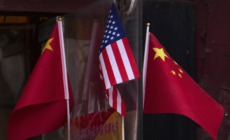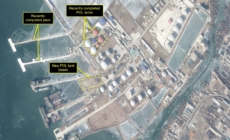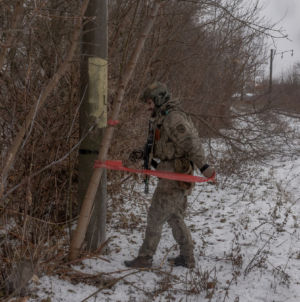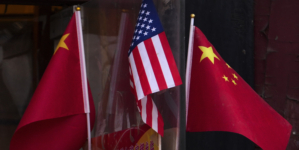-
Russian Soldier Froze to Death After Rogue Commander Tied Him to Tree—Report - 15 mins ago
-
Lawsuit Accuses University of California of Allowing Race to Factor in Admissions - 19 mins ago
-
US Warship Fires Laser Weapon in Stunning Photo - 50 mins ago
-
A Daring Rescue Under a Subway Train Leads to an Emotional Reunion - about 1 hour ago
-
China Strikes Back Over US Tariffs Imposed by Trump - about 1 hour ago
-
Proud Boys Lose Control of Their Name to a Black Church They Vandalized - 2 hours ago
-
Satellite Photos Show North Korea Expanding Major Seaport - 2 hours ago
-
As Australia’s Election Nears, Peter Dutton Has a ‘Trump Lite’ Approach - 3 hours ago
-
Groom Furious “Greedy” Bride Wants to Save Wedding Money for Future Children: “Rude” - 3 hours ago
-
Parent Agonizes Over How to Tell Friend Secret They’ve Kept for 12 Years: “Just Tell Him” - 3 hours ago
What Does Trump Really Want From Canada and Mexico?
President Trump has long been clear that he would use tariffs as an economic sledgehammer against nations that refuse to bend to his demands.
He has been far less clear about what, exactly, those demands are — a strategy that allows him to declare victory when he sees fit.
Mr. Trump has said he wants Canada and Mexico to stop the flow of migrants at the border and curtail shipments of fentanyl. But at least publicly, he has offered only vague benchmarks to gauge their cooperation. Asked on Monday whether there was anything Prime Minister Justin Trudeau of Canada could offer to avoid tariffs, Mr. Trump said, “I don’t know.”
“We have big deficits with Canada like we do with all countries,” Mr. Trump said from the Oval Office. “I’d like to see Canada become our 51st state.”
In the end, Mr. Trump decided to postpone, for 30 days, the imposition of tariffs on Canada and Mexico, sidestepping a crisis that could have roiled the global economy. He suggested that he had wrenched concessions out of the United States’ neighbors, with Canada appointing a “fentanyl czar” and launching a joint strike force to combat organized crime and money laundering. Mexico, Mr. Trump said, promised to reinforce the U.S.-Mexico border with 10,000 members of its National Guard.
But it was not clear that any of those measures were major concessions. Mr. Trudeau, in a social media post, described actions that were already in progress under his country’s $1.3 billion border plan, including the deployment of additional technology and personnel to the border. Just a sliver of the total amount of fentanyl seizures occur at the U.S.-Canada border, according to federal data.
Mexico had already ramped up border enforcement before Mr. Trump’s tariff threat, and illegal crossings have plummeted. During President Claudia Sheinbaum’s first four months in office, Mexican security forces have carried out major seizures of fentanyl and stepped up operations to locate and destroy clandestine fentanyl labs. Drug fatalities in the United States declined last year after years of unrelenting overdose spikes.
“He thrives in chaos, he thrives in uncertainty,” John Feeley, the former U.S. ambassador to Panama and deputy chief of mission in Mexico, said of Mr. Trump. “He doesn’t need to have a metric. You’re making a mistake if you think he’s sitting there with a spreadsheet. He’s not. He’s sitting there looking at headlines.”
The ambiguity over the details of Mr. Trump’s demands appears to be as much a part of his strategy as the threat of tariffs themselves. Leaving his demands something of a mystery allows him to decide when to end the negotiation.
Karoline Leavitt, the White House press secretary, said on Monday that Mr. Trump had been “astoundingly clear” about his reasoning for the tariffs.
“The illegal surge of deadly drugs and of human beings that we have seen trafficked over the southern border and northern border,” Ms. Leavitt said. “The president is making it very clear to both Canada and Mexico that the United States is no longer going to be a dumping ground for illegal deadly drugs and illegal human beings.”
Canada has tried to make the case directly that it was already doing many of the things Mr. Trump was calling for. Mélanie Joly, Canada’s foreign minister, had visited the United States five times since Mr. Trump’s election, leaving Tom Homan, Mr. Trump’s border czar, optimistic about their work.
In an interview, Ms. Joly said she saw Mr. Homan in Washington on Friday and shared a two-page explanation and a time-lapse video of their work on the border to make the case Canada was taking border security seriously.
Mr. Homan said in an interview over the weekend that Canada was “improving” its border security but said Mr. Trump did “not feel like they’ve done enough, and that’ll be his call.”
Mr. Trump continued to hang the tariffs over Canada until Monday.
Mexico’s promise to boost enforcement at the border is likely to provide Mr. Trump an assist as he tries to impose sweeping restrictions to turn away thousands of migrants. To be sure, some U.S. officials have in recent years expressed concern that Mexico was not consistently prioritizing border security measures.
But Mexico had already agreed to beef up enforcement of the border roughly a year ago, after the Biden administration grew concerned that Mexico was not policing its own borders well enough. Illegal border crossings have fallen significantly. Mexico also agreed to deploy 10,000 troops to help with migration enforcement in 2021, without the threat of tariffs. Ms. Leavitt said the deployment announced on Monday would be permanent.
In the two weeks since he has taken office, Mr. Trump has shown willingness to use blunt force on the global stage. He threatened tariffs on Colombia for refusing to accept U.S. military flights of deported migrants, and Colombia quickly backed down.
Andrew Selee, the president of the Migration Policy Institute, said it was still unclear what Mexico and Canada would need to do to avoid U.S. tariffs. But in the meantime, he said, both Mr. Trump and Ms. Sheinbaum are likely to benefit politically from the outcome of their back-and-forth.
Mr. Trump can brag about securing more troops at the border, and Ms. Sheinbaum can celebrate her efforts to face Mr. Trump head-on.
“I think the Mexican government would like to know what the end game is, but the fluid nature of the negotiation probably helps both sides,” Mr. Selee said.
Hamed Aleaziz and Jonathan Swan contributed reporting from Washington.




















